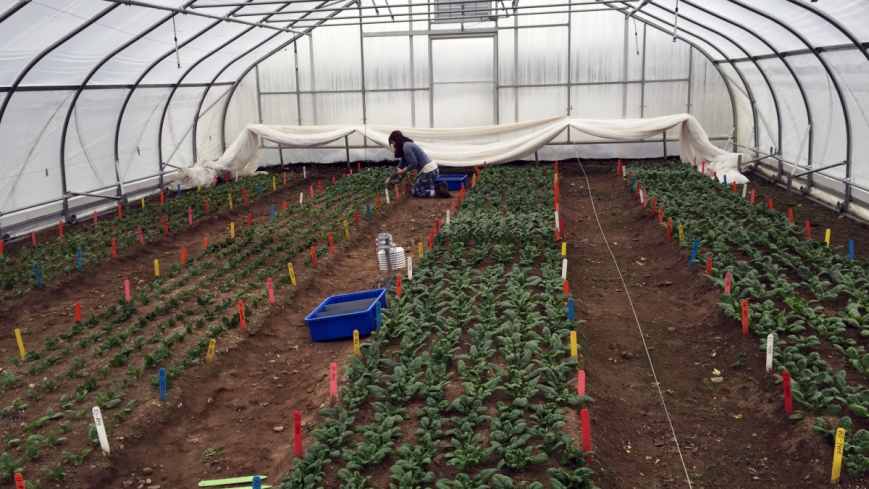Research On Growing Spinach In Winter Helps Determine Planting Dates

Undergraduate student assistant Talia Levy harvests spinach on Dec. 18, 2015. The row cover you see at the end of the tunnel is removed for harvest and then replaced for added warmth. Photo credit: Kaitlyn Orde/UNH

New Hampshire growers and others in the region interested in adding spinach to their winter crop production soon will have additional information to help them select which varieties to grow and when to plant, thanks to a research project underway at the New Hampshire Agricultural Experiment Station’s Woodman Horticultural Research Farm.
Becky Sideman, a researcher with the New Hampshire Agricultural Experiment Station and Extension professor of sustainable horticulture production, Kaitlyn Orde, a graduate student in agricultural sciences, and Connor Eaton, a graduate student in plant biology, are conducting a winter spinach trial to determine the most suitable spinach varieties and planting dates for winter production in New Hampshire in an unheated high-tunnel environment.
Whether a grower has existing high tunnels that are unused in the winter and may be interested in starting winter greens production, or already produces spinach but is interested in other varieties and planting dates, this study addresses the range of grower needs.
“Many New Hampshire growers are either interested in winter spinach production or already raise winter spinach to some extent in unheated high tunnels, but there has been very little research that can help growers make decisions about planting dates or varieties for cold-season production in our region,” Orde says.
“The traditional growing season in New Hampshire is very short, limiting the period for local food production. Growing systems that allow for an extended period of production can help support agriculture in the state and supply more locally produced food on a more consistent basis,” she says.
Researchers are collecting yield, sugar content, ease of harvest, and average leaf size measurements from eight spinach varieties planted on six different dates from mid-September to early November. The varieties the University of New Hampshire is using are ‘Regiment,’ ‘Tyee,’ ‘Space,’ ‘Gazelle,’ ‘Corvair,’ ‘Renegade,’ ‘Emperor,’ and ‘Carmel.’
“Results from this experiment should allow us to confidently provide recommendations to growers on the highest yielding and quality varieties, and provide some target planting dates. Knowing the spread and peaks in production would allow growers to match their harvest peaks with good sales opportunities such as at Thanksgiving and Christmas, or stagger plantings to harvest continuously through the winter,” Orde says.
Although the research project is ongoing, scientists report they already have seen great variation in plant type and growth habit between varieties, affecting ease and pace of harvest. They also have seen differences in leaf size, color, and texture, leading them to theorize that some varieties may be better suited for fresh eating, such as sold as a salad mix or used in cooking.
According to Orde, researchers also have found that winter spinach production is low maintenance. Aside from harvesting and the occasional irrigation or pest control, it has been very easy to produce high-quality greens. Researchers have not encountered any major challenges this year, and the spinach has been very productive due to the warm weather.
Researchers will continue harvesting until plants are either no longer producing saleable spinach leaves or until the tunnel is converted to another crop for spring or summer production, as a grower would do. They then will start summarizing their results to share with farmers and gardeners that are interested in growing spinach during the cold winter months.
This material is based upon work supported by the New Hampshire Agricultural Experiment Station, through joint funding of the National Institute of Food and Agriculture, USDA, under award number 228522, and the state of New Hampshire.










